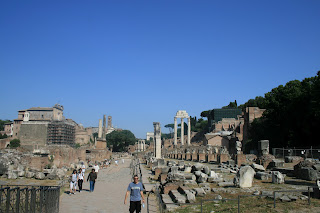After rehydrating, refueling, and re-UVB-protecting, we set off down the road to the Foro Romano, or Roman Forums.
A forum was a type of plaza, which was the heart of Ancient Rome, and the Empire. It served as a marketplace, venue for public events, and meeting place for politicians and businessmen, as well as housing some of Rome's most important and religious buildings and statues. It evolved naturally over the years, expanding as various structures were added, which is very different to later forums which were rigidly copied from Greek plazas.
Nowadays, it is a jumble of assorted ruins and bits of marble, and almost entirely impossible to navigate. Sadly, Italians don't seem to believe in labelling things. However, my guidebook reliably informs me I saw some very exciting ruins, such as:
- Tempio di Saturno (Temple of Saturn), which dates from 42AD (an earlier temple standing there from 500BC). This was very important as Rome's early power was attributed to its success with agriculture, Saturn's particular field of interest. He was also seen as the god of wealth, so the city's treasury was housed here.
- Tempio di Antonino e Faustina (Temple of Antoninus and...you get the picture), built in 161AD by Antoninus for his wife Faustina. Faustina was...er...slightly less choosy about who she lay down with, but Antoninus was besotted and seemed to be the only person in Rome who did not know his wife was a bit of a floozy.
- Tempio di Giulio Cesar, built in 29AD on the site of Julius Caesar's cremation.
- A 1937 reconstruction of the Curia, the meeting place of the senate.
- Arco di Settimio Severo, an archway dedicated to Professor Severus Snape...I think.
- The site at which 'all roads lead to Rome' actually referred to, the Millarium Aureum. This was a monument built in 20AD from which all distances to other city's was measured. All Roman roads across the Empire converged here (in theory).
However, my personal favourite ruins was the Tempio di Vesta and the Atrium Vestae. Vesta was the goddess of the hearth and family, and the Vestal Virgins were her priestesses. The Virgins were selected from the wealthiest, most influential families of Rome at the age of between 6-10, and they served for 30 years; 10 years learning, 10 years performing rituals, and 10 years teaching new Virgins.
They had two main jobs. The first, was to keep alive the sacred fire, which burned in the temple. This fire was so important that is was regarded as fundamental to Rome's security and the continuation of the Empire. Any Virgin allowing it to go out would be whipped by Rome's high priest, the Pontifex Maximus.
The Virgin's second job was exactly that: to remain a virgin. If their cherry was popped, they were buried alive, as it was sacrilege to spill a Virgin's blood. The man who popped their cherry for them was flogged to death.
In payment for their service/chastity the Virgins had special rights within Roman society, and could intervene in sentencing of criminals (in fact, they secured a pardon for Julius Caesar when he was younger, and saved him from execution). They had right of way on all streets, and any injury or attack on them was punishable by death. They were paid by the state's treasury, and upon completing their service they were awarded a pension and allowed to marry.
After the Forum, we climbed the hill to the Palatine, the oldest settlement of Rome. It is supposedly the site at which the she-wolf suckled Romulus and Remus, the founders of the city of Rome.
Romulus and Remus were fathered by either Mars, the god of war, or Hercules, that well-known Disney actor. Interestingly, their mother was a Vestal Virgin, and had been forced into this life of servitude by her uncle, to prevent her having male heirs who could overthrow her dastardly uncle and take their place as rightful ruler the city of Alba Longa.
Whoops.
After R&R were born, their great-uncle abandoned them to die at the side of the river Tiber. However, the river bore the twins to safety, and they ended up on the top of the Palatine hill (yunno, because rivers are well known for flowing up hills). Here they were suckled by a she-wolf and fed by a woodpecker until a shepherd found them and took them in. When they had grown up, they discovered the truth about their birth, and killed their evil great-uncle.
Whoops again.
However, they wanted to form their own city rather than take over Alba Longa, but couldn't decide where to form it. Romulus wanted the Palatine Hill, whereas Remus the nearby Aventine Hill. They quarrelled and, as so often happened in those days, Remus was killed, and Romulus set up Rome on the Palatine Hill. Even as Rome expanded, the Palatine remained the site of the grandest and most spectacular of palaces (Palatine...Palace...you get the gist).
As a side note, myth says that Romulus and Remus were descended from Aeneas, one of the princes of Troy, who fled when the Greeks jumped out of the Trojan Horse and killed everyone. It is this flight of Aeneas which is recounted in Virgil's Aeniad, the first example of political propaganda in history.
We managed to get quite lost in the Palatine, and couldn't work out where the exit was. However, our increasingly fraught wanderings did lead us to some sprinklers, where we joined another tourist in an impromptu shower. Eventually we escaped, and set off home.
For tea it was rigatori cacio e pepe (short pasta with cheese and pepper), a rather biscuit-like focaccia and gelato - our first ice cream of many. I had pistacchio Iranicchio (pistachio and Iranians) and ciacocchio fondente (the chocolatiest substance in the world).
And so began the creation of my newest layer of stomach fat...





No comments:
Post a Comment